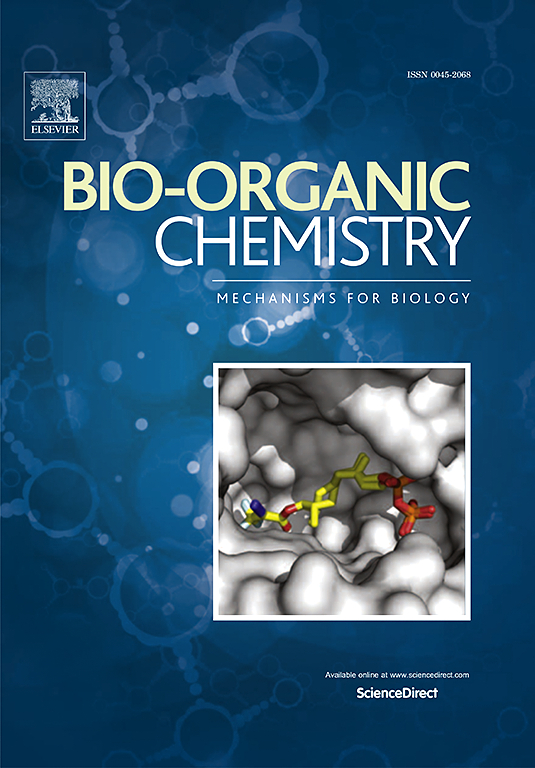Discovery of polycyclic polyprenylated acylphloroglucinols with antitumor activities from Garcinia pedunculata Roxb. fruits based on molecular networking
IF 4.5
2区 医学
Q1 BIOCHEMISTRY & MOLECULAR BIOLOGY
引用次数: 0
Abstract
Garpedvinin A (1), a novel polycyclic polyprenylated acylphloroglucinol (PPAP) with a bicyclo[4,2,1]nonane core, 13 previously undescribed PPAPs, garpedvinins B-N (2-14) and 6 known analogs (15-20) were isolated from Garcinia pedunculata by various chromatographic methods combined with Global Natural Products Social Molecular Networking. The structures were identified by the analyses of spectral characteristics, computational chemistry calculations and single-crystal X-ray diffraction. A plausible biosynthetic pathway for garpedvinin A was suggested based on the isolated precursor, cambogin. Compounds 2-6, 8, 11, 13, 15-18 and 20 displayed cytotoxic effects on three cancer cell lines, HepG2, A549 and MCF-7. 6 showed the strong inhibitory effect on the proliferation of HepG2 cells in vitro, inducing cell apoptosis in a concentration-dependent manner and blocking the cell cycle at the S phase. Furthermore, 6 affected the expression of apoptosis-related proteins Bax, Bcl2 and pro-Caspase-3.

具有抗肿瘤活性的藤黄多环聚丙烯化酰基间苯三酚的发现。基于分子网络的水果
garpedvina(1)是一种新型的多环聚丙烯酰化酰基间苯三酚(PPAP),其核心为双环[4,2,1]壬烷,通过各种色谱方法结合Global Natural Products Social Molecular Networking从Garcinia pedculata中分离得到13个先前未被描述的PPAP, garpedvinins B-N(2-14)和6个已知的类似物(15-20)。通过光谱特征分析、计算化学计算和单晶x射线衍射对其结构进行了鉴定。提出了一种基于分离前体柬埔寨素的石蒿甲素A的生物合成途径。化合物2-6、8、11、13、15-18和20对HepG2、A549和MCF-7三种癌细胞具有细胞毒作用。6对HepG2细胞体外增殖有较强的抑制作用,呈浓度依赖性诱导细胞凋亡,阻断细胞周期S期。此外,6影响凋亡相关蛋白Bax、Bcl2和pro-Caspase-3的表达。
本文章由计算机程序翻译,如有差异,请以英文原文为准。
求助全文
约1分钟内获得全文
求助全文
来源期刊

Bioorganic Chemistry
生物-生化与分子生物学
CiteScore
9.70
自引率
3.90%
发文量
679
审稿时长
31 days
期刊介绍:
Bioorganic Chemistry publishes research that addresses biological questions at the molecular level, using organic chemistry and principles of physical organic chemistry. The scope of the journal covers a range of topics at the organic chemistry-biology interface, including: enzyme catalysis, biotransformation and enzyme inhibition; nucleic acids chemistry; medicinal chemistry; natural product chemistry, natural product synthesis and natural product biosynthesis; antimicrobial agents; lipid and peptide chemistry; biophysical chemistry; biological probes; bio-orthogonal chemistry and biomimetic chemistry.
For manuscripts dealing with synthetic bioactive compounds, the Journal requires that the molecular target of the compounds described must be known, and must be demonstrated experimentally in the manuscript. For studies involving natural products, if the molecular target is unknown, some data beyond simple cell-based toxicity studies to provide insight into the mechanism of action is required. Studies supported by molecular docking are welcome, but must be supported by experimental data. The Journal does not consider manuscripts that are purely theoretical or computational in nature.
The Journal publishes regular articles, short communications and reviews. Reviews are normally invited by Editors or Editorial Board members. Authors of unsolicited reviews should first contact an Editor or Editorial Board member to determine whether the proposed article is within the scope of the Journal.
 求助内容:
求助内容: 应助结果提醒方式:
应助结果提醒方式:


